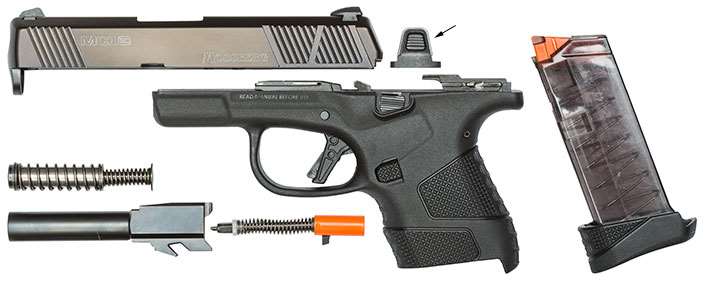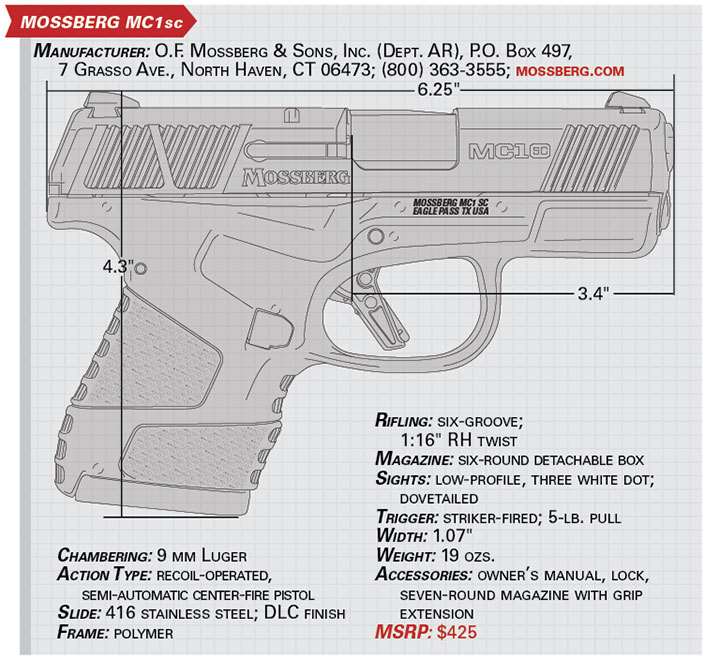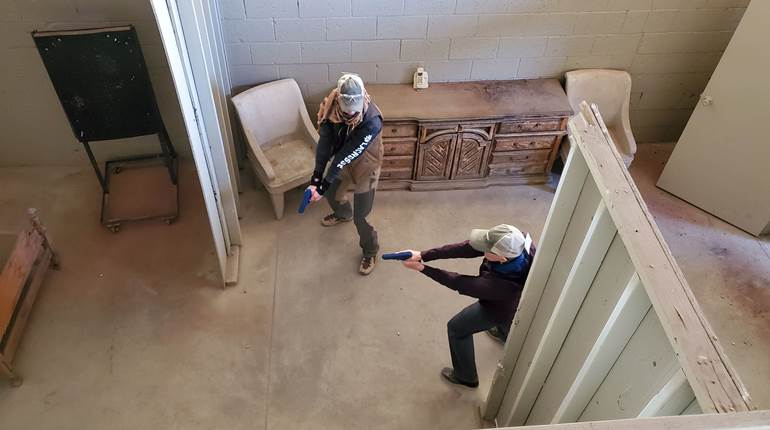
For me, Mossberg firearms are epitomized by the dozen or so M500 pump-action shotguns filling a rack in the armory of Comanche Troop, 4/7 CAV, at Camp Hovey, Republic of Korea. I can’t be sure of the guns’ whereabouts today, but they were already well-tenured residents during my rotation to the U.S. Army installation during 2008 and 2009. Used and abused would be an apt description of their service experience. The shotguns had been handled by countless soldiers, shot during familiarization training and qualification fire, and issued often for field exercises during which they would rattle around in the back of a HUMVEE or get strapped to the newest troopers’ packs to be dragged up, down and around Korea’s mountainous terrain. They were tools and were treated as such. And, like the best tools, they were tough, gritty and reliable. No one could say the pump-action assemblies of those guns ever cycled smoothly, but they always cycled.
Mossberg’s newest product, the MC1sc—for Mossberg Carry 1 Subcompact—retains the reliability and utility for which the company is known, but provides an evolved experience compared to classic offerings. Though the trade winds have been, for years now, blowing strongly toward handguns suitable for personal defense and concealed carry, Mossberg has relied upon its sporting- and service-oriented rifles and shotguns, and has won a following of loyal customers through innovative offerings such as the 590 Shockwave pump-action, the AR-magazine-fed MVP series of rifles, and the user-customizable FLEX system of stocks and grips. With longarms currently in use by the military and law enforcement, and a century’s worth of field experience with American sportsman and armed citizens, the rifles and shotguns from North Haven, Conn., and Eagle Pass, Texas, have garnered a strong reputation for quality, reliability and affordability.
Such a company, then, could easily have stumbled when attempting to introduce its first handgun in nearly 100 years. For those who don’t know, Mossberg’s very first commercial firearm was actually a pistol; the 1919 Mossberg Brownie was a four-barreled .22 rimfire intended for use by trappers, though it also found some acceptance as a vest-pocket defensive arm. However, despite the long hiatus from the handgun market, the MC1sc stands as a testament to Mossberg’s heritage of performance and value, and boldly leaps into relevance as one of the most refined concealed handgun offerings in what is now a well-established category. I can only speak for myself, but the MC1sc surprised and impressed me with its aesthetic appeal, excellent ergonomics, unquestionable utility and unwavering reliability. In short, it’s a pistol that Mossberg can be proud of, and it may launch the company into its next hundred years of firearm design and manufacture.

Within the concealed carry market at large, the MC1sc will find itself quite at home, and among good company. It’s no mistake that the new Mossberg bears more than a passing resemblance to category stalwarts such as the Smith & Wesson Shield, Glock 43 and Springfield Armory XD-S. Those pistols have been wildly successful commercial offerings, and the small-frame, single-stack, semi-automatic in 9 mm Luger continues to be a proven winner. Given the success of competitive firearms, it does beg the question as to why Mossberg would choose to take on some of the most popular pistols of the day with its first handgun offering in a century. The answer, according to Mossberg, was based on extensive market research. The company found that despite the plethora of excellent offerings, there is still unmet demand for subcompact pistols in this configuration.
Turning our attention directly to the new Mossberg, it’s useful to examine the pistol independently, and then I’ll clue you in on some very interesting, and largely unadvertised, crossover capabilities. The MC1sc is a striker-fired, recoil-operated center-fire pistol chambered for 9 mm Luger. It uses a 3.4" barrel of 416 stainless steel that is button-rifled with a six-groove, 1:16" twist, and features a diamond-like carbon (DLC) finish for increased resistance to wear and fouling. A subcompact both in name and size, the pistol weighs 19 ozs. unloaded, is 6.25" long and stands 4.3" tall with the six-round, flush-fitting magazine installed, or 4.75" with the seven-round extended magazine. Those magazines, by the way, are both “single-stack” in design, but I add the quotation marks because some staggering is readily apparent through their transparent polymer bodies—that’s right, transparent, but more on that later. The MC1sc is also very trim; the slide measures just a hair more than 0.9" wide, and the widest point on our sample gun was at the slide stop lever where it measured 1.07" across.
As one would expect from a new entry in this category, Mossberg opted to use an injection-molded polymer frame. Besides offering advantages in terms of weight savings, durability and reduced manufacturing costs, polymer pistol frames also afford designers a lot of latitude regarding shape, texturing and ergonomics. On the MC1sc, Mossberg took full advantage. The rounded heel paired with the shallow finger grooves yields a comfortable, hand-filling grip despite the slim frame. Two texturing patterns also improve purchase, the front- and backstrap feature vertically aligned ovate windows with stepped, pyramid-like flats—it’s an interesting design. The left and right sides of the frame have areas with a coarser, finely detailed crosshatch pattern. The combination of shape and texturing are very effective for anchoring the gun in the hand.

While on the topic of the frame, it is worth examining the pistol’s controls. My evaluation model featured a left-side-only slide stop lever, a magazine release button that is reversible for right- or left-handed use, and, of course, the trigger, which is of a flat-faced design—a feature increasingly popular as an aftermarket upgrade for competitive pistols—and is equipped with the central blade-style safety lever. There is no manual safety on the test gun, but Mossberg is building versions of the MC1sc equipped with crossbolt safeties which, like the magazine release, are user-reversible for righties and lefties; instructions for reconfiguring the controls can be found in the owner’s manual. Coming back to the trigger, the pistol operates with a striker-fired action so the trigger pull is very consistent shot to shot. Mossberg advertises that the MC1sc exhibits 0.5" of trigger travel, and that calculation was spot-on for my evaluation sample—0.25" of take-up followed by a defined break and another 0.25" of overtravel. Reset comes after just 0.25" of forward travel—right at the trigger’s breaking point—and is easily distinguished by clear audible and tactile cues. In terms of trigger pull weight, Mossberg advertises 6 lbs. of pressure as the requirement, but the average of 10 pulls with the test gun using a Lyman digital trigger gauge was exactly 5 lbs., and none of the measured pulls were more than +/- 3 ozs. from 5 lbs. It is a very good trigger.
Moving to the top half of the gun, the MC1sc’s slide is also machined from 416 stainless steel and receives the same black DLC finish as the barrel. Angled serrations are present both in the usual rearward location, as well as at the front of the slide. They are actually back-cut, giving each groove an extra bit of bite and providing very positive engagement with the shooter’s fingers. The entire slide has also been dehorned, giving the gun a smooth and polished appearance. Although forward cocking serrations and a thorough dehorning job have long been the specialty of custom gunsmiths, and are oft-sought aftermarket modifications, both features are standard-issue on the Mossberg. Topping the slide are low-profile steel sights. My test pistol’s sights were in the familiar three-white-dot configuration, but Mossberg also offers the gun with TruGlo Tritium Pro night sights. The sights are secured via dovetail cuts in the same pattern as many SIG pistols, so compatible aftermarket options are plentiful and readily available.
Compatibility is one of the standout features of the MC1sc, and it’s not limited to the sights. Too often, in my opinion, we see companies launch new firearm designs that utilize proprietary—and often unproven—magazines, which are a pretty important component when it comes to ammunition storage, feeding and overall gun functionality. Likewise, handguns always bear the added concern of holster fit. Outside of the two or three most popular pistol manufacturers, aftermarket support for a new platform may lag behind the introduction, and may be quite limited in scope and variety. Given that the MC1sc is Mossberg’s first pistol in a century, and considering its use of proprietary magazines, one would be right to worry about aftermarket support.

Fear not.
Even though Mossberg isn’t likely to advertise it, the MC1sc has some serious cross-compatibility with a very popular pistol that should set your mind at ease. Ever heard of Glock’s G43? The MC1sc functions flawlessly with factory Glock G43 magazines. Also, the Mossberg will fit most G43 holsters. Don’t think you can fit a round trigger guard into a square space? Think again; the internal dimensions of the MC1sc’s trigger guard are similar to the G43 and therefore engages the retention features of Kydex holsters—I tested half a dozen from various makers, and they all worked. The external dimensions are similar as well, so leather rigs should be no problem. Mossberg has shown some serious savvy by designing the MC1sc to be compatible with the sights, magazines and holsters of other, more established handgun models. In so doing, the company completely sidestepped the requirement of developing an accessory aftermarket, which can be a major barrier for newly introduced firearms. Oh, and did I mention that a version of the MC1sc will also be available pre-equipped with a Viridian trigger guard-mounted red laser? The laser sights will be available separately as well, so those who prefer an additional aiming device, Mossberg’s got you covered on that front.
If you’ve followed along, a picture should be taking shape wherein Mossberg, despite being out of the handgun game for most of the past 100 years, has introduced a very refined personal-defense pistol that is heavily influenced by and, in many ways, similar to its more seasoned competitors. One area where the MC1sc breaks away from the crowd is in its safe disassembly procedure. Rather than incorporating takedown levers or tabs, or requiring the trigger to be pulled during disassembly, Mossberg engineered an entirely different method to improve safety during maintenance. With a cleared gun—magazine removed and chamber checked—users need only lock the slide to the rear, remove the rear slide plate by pressing the integral button and pulling it down and out, and then extract the striker assembly from the rear of the slide (the component is especially hard to miss thanks to its blaze orange polymer shroud).
Mossberg’s method completely removes the mechanical components required to impact a cartridge’s primer, rendering the now-partially disassembled gun inert. How’s that for safe? With the striker assembly removed, simply release the slide assembly and ride it forward off the frame in order to access the barrel, recoil spring assembly and the frame’s internals. The recoil spring, by the way, is a dual-captured assembly—again, a proven design for guns of this size and type.
To introduce the new pistol and put it through its paces, Mossberg chose the tried-and-true approach of inviting a group of gun writers to Paulden, Ariz., to take part in three days of shooting at Gunsite Academy. This venue has seen its share of new product introductions, and has humbled more than a few guns due to the combination of heat, dust and high-volume shooting. The Mossberg representatives may have even questioned their decision to hold the event when, on the morning of Day 1, many of us questioned aloud why the company would ever jump into the compact polymer pistol arena, already convinced its clear magazines wouldn’t survive the week. It was, indeed, a particularly outspoken congregation, most of us having carried a gun for a living, and the remainder being civilian shooters who nonetheless take their pistolcraft seriously. Our “constructive criticism” wasn’t reserved for Mossberg, either. One evening the group went to a local restaurant for dinner and refreshment. After ordering a bourbon, neat, one attendee—who shall remain nameless—agreed to sample the bartender’s “counter-offer” of a small-batch, craft-style, independently distilled Irish whiskey. The barman regaled us for three or four minutes about the merits of his no-doubt-hipster-infused spirits. Upon taking a sip of the proffered liquor, and with the barkeep leering over his shoulder, the attendee simply said it “Tastes a bit of wet dog,” and politely repeated his order of bourbon, neat. All in all, it was a group that didn’t mince words or hold back opinion. Little did we know that by the end of Day 3 we’d all walk away impressed.

During the event, more than a dozen pistols were shot to the tune of 500 to 1,000 rounds, each—using a mix of American Eagle 115-gr. FMJs and Hornady Critical Duty 135-gr. FlexLocks—and experienced exactly zero stoppages or malfunctions. That’s something I’ve never seen at a Gunsite industry event. We shot steel and paper on the square range at distances of 3 yds. to 50 yds. for accuracy and from the holster for time. We shot our way through outdoor simulators such as Gunsite’s “Donga” course, and fought through shoot houses with frangible ammunition. Frequent NRA Publications contributor Richard Mann even wanted to see if the MC1sc would cycle 9 mm Luger snake-shot loads, a feat very few semi-automatics are capable of—the gun ran perfectly. And those clear polymer magazines? We abused those things, even tossing them around the range, stepping on them and covering them in sand. They worked just fine. The general category of transparent plastic pistol magazines has earned a dubious reputation due to inconsistent quality from various makers, but Mossberg’s magazines are manufactured to the company’s exacting specifications and have been the model of reliability throughout my testing. One cautionary note, it is easy to squeeze an extra round into some of the magazines, and doing so may affect the pistol’s functionality. Mossberg is aware of this issue and is currently exploring remedies for future production. Until then, please don’t overload your magazines.
Upon returning from the Gunsite event, my testing continued at the NRA Headquarters range with the American Rifleman protocol testing. The protocol includes using three types of ammunition, each of which is chronographed to determine velocity and energy, and accuracy testing is conducted by firing five consecutive, five-shot groups at 7 yds. due to the pistol’s sub-3.5" barrel and intended role as a concealed defensive arm. I chose to test the gun with Aguila’s 115-gr. FMJ ammunition, which I have found to be an excellent and affordable range load, Hornady’s American Gunner 124-gr. XTP +P load, which is a great all-around cartridge—the MC1sc is rated for use with +P ammunition, but the manual advises against using +P+ loads—and SIG’s 365 115-gr. V-Crown JHP personal-defense ammunition which has been formulated to perform well in short-barreled pistols. The full results of my testing are tabulated nearby, and several sub-1" groups with the Aguila and Hornady loads confirmed what I’d already learned at Gunsite by ringing 12" steel at 50 yds.—the MC1sc is a very accurate little gun.

When the smoke clears and the brass has all been swept, I’m interested to see how the market responds to the MC1sc. Afterall, this is a pistol that a company like Mossberg had no business making. This is no rough-around-the-edges pump-action; reliable, yes, but this one is also thoughtfully refined. Common-sense upgrades such as forward slide serrations and magazine cross-compatibility have eluded companies in this market for years, companies that do nothing but build handguns. And if that weren’t enough, true to tradition, Mossberg is going to offer the pistol at an exceedingly reasonable price so that regular guys and gals, the company’s faithful fans, can afford the newest addition. The MSRP on the base model gun is listed at $425, but I’ve seen it advertised by some sellers at less than $350. The folks at Mossberg may have had no business making this gun, but they did, and 100 years on, they’ve managed to put the rest of the market on notice.

Additional Reading:
2019 First Look: Mossberg MC1sc Pistol





































